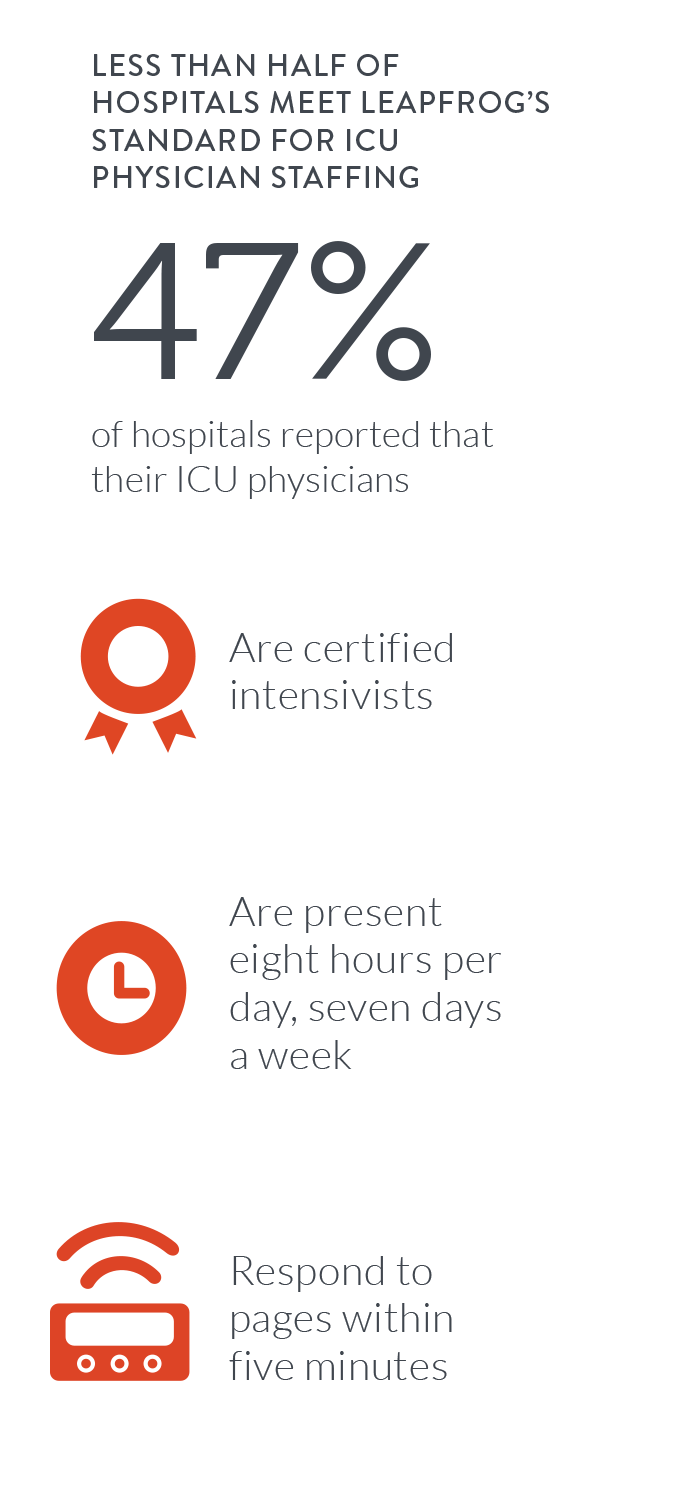
Hospital intensive care units (ICU) see 4.6 million people annually, among them some of the nation’s sickest and most vulnerable patients. Studies show that patient survival increases by 40 percent when ICUs are staffed appropriately with highly specialized physicians called intensivists, yet a new report released today by health care non-profit The Leapfrog Group and analyzed by Castlight Health indicates that only 47 percent of hospitals reporting in the 2015 Leapfrog Hospital Survey have the recommended intensivist coverage in place.
Leapfrog’s standard calls for hospitals to have one or more board-certified intensivists on staff, exclusively providing care in the ICU, available for eight hours per day, seven days a week, and for intensivists to return calls within five minutes, 95 percent of the time. Hospitals can partially meet the standard by having intensivists available via telemedicine.
"Having an intensivist present in the ICU saves lives, period." - Leah Binder, President and CEO
“Having an intensivist present in the ICU saves lives, period,” said Leah Binder, president and CEO of Leapfrog. “Patients and families should be on high alert if their hospital lacks this essential coverage. Moreover, if their hospital has declined to report at all, the public has no way of knowing about how the ICU is staffed. Patients who find that their hospital did not respond to the Leapfrog Hospital Survey should send a note to hospital administrators explaining why they want this information and expect full transparency.”
Key findings from the report include:
-
Hospitals’ adoption of ICU physician staffing standards varies by state: The percentage of hospitals meeting Leapfrog’s standard was highest in Arizona, where 87 percent of reporting hospitals in the state met the standard. At least 60 percent of hospitals met the standard in six additional states, while in 10 states, fewer than 30 percent of hospitals did. There was no state in which 90 percent or more of hospitals met the standard.
SOURCE: Castlight Health analysis - Implementation of ICU physician staffing has increased steadily, but has yet to surpass the 50 percent mark: In 2007, only 30 percent of hospitals had ICU physician staffing that met Leapfrog’s standards. By 2015, that rate had increased to 47 percent. In recent years, there has been a slow but steady increase of one to four percentage points.
- More transparency is needed: Some hospitals decline to report on their ICU staffing, which should raise concerns for patients. There is no other publicly available source for this information.
“Hospital quality and cost information is vital to enabling individuals to make the best choices for their health,” said Kristin Torres Mowat, senior vice president of plan development and data operations at Castlight Health. “Leapfrog’s data illustrates how essential it is to report ICU physician staffing. Proper intensivist staffing is crucial to the proper care of patients with the most critical need. This study and Leapfrog’s work are important to driving visibility and change in hospital practices, which will ultimately lead to better patient care.”
Today’s report is the last in this year’s series of five that examines key quality and safety measures at hospitals nationwide. The series draws on data from the 2015 Leapfrog Hospital Survey of 1,750 U.S. hospitals, representing 60 percent of the inpatient beds nationwide, with analysis provided by Castlight Health. Previous publications in the series can be found here.
